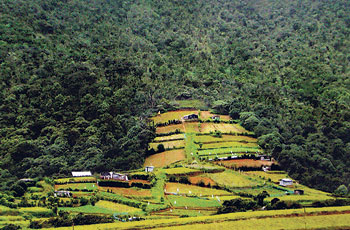Legend has it that Hakgala was King Ravana’s pleasure garden where he kept the beautiful princess Sita whom he had abducted from India. Today, visitors to the hill country rarely miss out on a visit to Hakgala and while walking around many wonder what lies behind the fences of the Botanical Gardens.
Only few realize that it is the Hakgala Strict Nature Reserve (SNR), a montane cloud forest, as important as the rainforests of Sinharaja or Knuckles in terms of biodiversity and watershed capacity.
Like any other SNR, Hakgala is restricted to all but those who are involved in scientific research and even they can enter only with a special permit obtained from the Department of Wildlife Conservation (DWLC).
Even amidst all this protection, the Hakgala SNR (declared in 1938, Hakgala is one of three Strict Nature Reserves and is the only one in the wet zone, the other two, Ritigala and Yala Block II, being in the dry zone) is under serious threat due to land-grabs and encroachment, problems that have dogged it for decades.
 |
| Picture showing the extent of the encroachment- Courtesy- Nuwara Eliya Nature Protection Society |
These were some of the shocking disclosures at a recent forum organized by the Environmental Foundation Limited (EFL) to launch ‘Hakgala Under Threat – A Review of Conservation Status and Management Needs’.
As much as 25% of the Hakgala SNR has been encroached on, a survey by EFL has revealed. This is indeed an alarming trend considering the fact that Hakgala is also protected by another law which prohibits the granting, leasing or otherwise disposal of state lands over 5,000 ft in altitude. Hakgala being above 5400 ft, therefore, also comes under this protection.
However, encroachers at Hakgala include the Ambewela cattle farm, Warwick tea estate and other small-scale cultivators who have occupied sections of it.
According to the Management Plan drawn up in 1999 by the DWLC, 16% or 182.88 ha of the Hakgala SNR, were claimed to be under encroachment. A 2006 survey has found that there are 152 encroachments, excluding the Ambewela farm, covering about 50 hectares.
“But the boundaries considered in this survey are not those of the original survey plan. They include a much smaller area for Hakgala,” EFL officials point out.
EFL claims that the figures cited by DWLC are massive underestimates of the current encroachment problem which its own survey has indicated as covering 150 ha and involving at least 200 households. This together with the encroachments by the Ambewela farm doubles the DWLC figure.
Encroachment by the Ambewela farm had begun a few decades ago, with even a survey plan of 1945 by the Survey Department including sections of the Hakgala SNR as part of the farm. This error had been the starting point of the large scale encroachment of Hakgala, states the report issued by the EFL.
Hakgala, environmentalists point out, is part of the Central Highlands Forest Complex which has been identified as being of the highest national importance for watershed protection by the National Conservation Review. It plays a particularly significant role in maintaining stream-flow over the year, especially dry season flows while also acting as a ‘water tower’ for the Uva Basin and the Uma Oya. Therefore, degradation of Hakgala will affect the whole country.
Soil erosion will cripple large-scale hydro projects like Uma Oya and Rantambe by reducing water inflow. The sediments which will be deposited in the waterways due to soil erosion will flow down to the reservoirs causing problems.
Meanwhile, environmentalists explain that the area currently used as grazing lands have pastures with imported grass seeds that are alien to the area.
The threat of these grasses spreading in the SNR as invasive species is enormous, in the light of most national parks battling with invasive species. The close presence of cattle to wild animals could result in wild animals being vulnerable to pandemics like the hoof and mouth disease.
Concerned over the degradation of the Hakgala SNR and no action by the DWLC, the Environmental Foundation had stepped in, filing legal action against the DWLC in 1988 over illegal encroachments. While recognizing the 1938 boundaries, the court had ruled that attempts to bypass the legal provisions that afford the Hakgala SNR the highest protection should be disregarded and ordered the DWLC to remove all encroachers. Despite the DWLC giving an undertaking to court, no action had been taken to remove the encroachers.
Once again in March 2006, EFL had filed another case to halt further encroachment immediately and remove the present encroachers. The respondents – DWLC, Divisional Secretaries and other government institutions – had agreed to act but once again nothing had happened.
DWLC Director-General Ananda Wijesooriya told the forum that the department is working to remove illegal encroachers. However, the largest encroacher – the Ambewela farm -- is not considered at this stage.
World Bank representative Dr. Sumith Pilapitiya emphasized the need for other government departments that are more powerful to support the DWLC. “It should be a collective effort, otherwise the DWLC will get isolated. We have seen this happen in the past.”
“Hakgala is an important ecosystem and it is important to protect it before irretrievable damage is done to the Strict Nature Reserve,” said environmentalist Jagath Gunawardene. |

